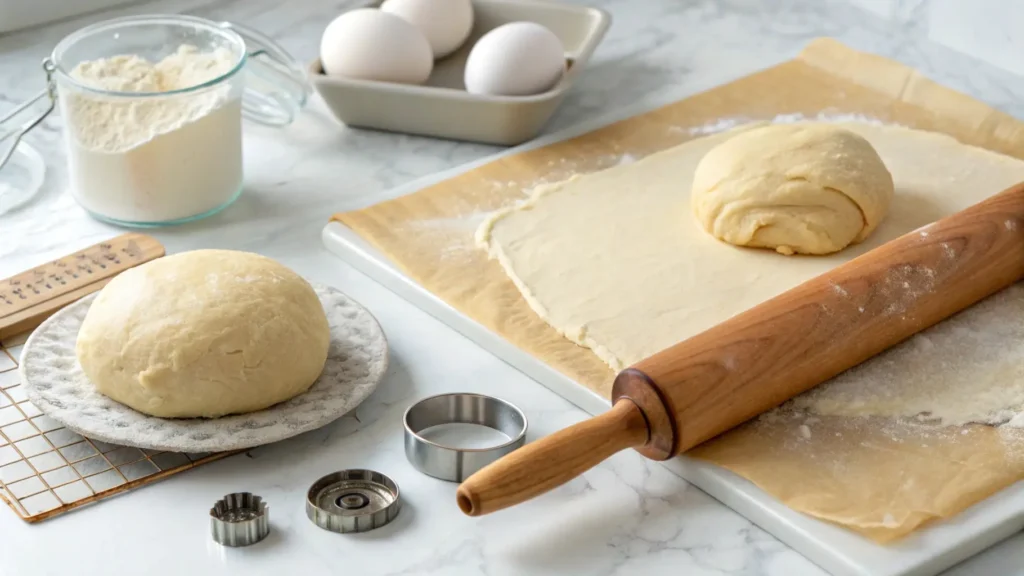There’s nothing more disappointing than pulling a tray of cinnamon rolls out of the oven only to find them dense and tough instead of light and fluffy. Baking cinnamon rolls can feel like a delicate balancing act, where everything from ingredient proportions to preparation techniques affects the final outcome.
In this article, we’ll uncover the most common reasons for dense cinnamon rolls and provide practical solutions for achieving the perfect texture. We’ll discuss common mistakes in dough preparation, ingredient handling, and baking techniques, ensuring you can troubleshoot and perfect your rolls. Let’s dive in!
Common Mistakes Leading to Dense Cinnamon Rolls
Overmixing: Why Are My Cinnamon Rolls Not Light and Fluffy?
One of the biggest culprits behind dense cinnamon rolls is overmixing the dough. When dough is mixed too much, gluten strands develop excessively, leading to a tough, chewy texture. Instead of creating a soft structure, overmixed dough traps the rolls in an undesirable density.
To avoid this, mix the dough just until the ingredients are combined and a smooth texture is achieved. Gentle handling is key—knead lightly with your fingertips rather than using aggressive force. If you’re using a mixer, stop as soon as the dough pulls away from the sides of the bowl.
Overproofing: Fixing Dense Cinnamon Rolls
Proofing, or allowing the dough to rise, is critical for developing flavor and texture. But overproofing can break down gluten structure and create a dense and deflated final product.
Watch the dough carefully during the rise. Ideally, it should double in size—nothing more. If it becomes overly puffy or starts to collapse when touched, it’s overproofed. To salvage overproofed dough, gently punch it down, reshape, and allow it to rise again for a shorter time.
Balancing Ingredients for Light and Fluffy Rolls
Too Much Salt
Salt plays a crucial role in baking. It controls yeast activity, improves flavor, and brings balance to the dough. But too much salt can dry out the dough, making it tough and dense. It absorbs moisture, leaving little behind to create that soft and airy texture you’re aiming for.
To avoid this issue, always measure your salt accurately. Use a kitchen scale or standard measuring spoons to guarantee precision. If you accidentally add more salt than needed, consider compensating with a touch of extra sugar or liquid to balance the dough. Remember, moderation is key—salt should never overpower your cinnamon rolls.
Using Excess Sugar
You might think that more sugar means sweeter, softer rolls, but it’s not always true. Excess sugar can interfere with the dough’s structure, making it sticky and harder to handle. When baked, this can result in dense and heavy rolls instead of light and fluffy ones.
Stick to the recipe’s recommended sugar quantity, especially in the dough. If you crave a sweeter result, add extra sweetness to the filling or glaze instead. This keeps the dough’s integrity intact while still giving you that satisfying sugary taste. Balancing sugar and salt is essential to resolving the age-old question: Why are my cinnamon rolls not light and fluffy?
Importance of Dough Handling Techniques
Not Letting the Rolls Rise Enough
Underproofed dough is a major factor behind dense cinnamon rolls. Without enough time to rise, the dough won’t develop the air pockets needed for that signature fluffiness. When rushed, you’ll end up wondering again, Why are my cinnamon rolls not light and fluffy?
To guarantee proper proofing, allow the dough to double in size before baking. This can take longer in cooler kitchens, so be patient. If your dough isn’t rising, check the temperature of your workspace. A slightly warm environment (but not too hot) will encourage the yeast to do its job effectively.
Uneven Rolling of Dough

Unevenly rolled dough creates uneven baking, and that can mean dense sections in your cinnamon rolls. If some parts of the dough are thicker than others, they’ll take longer to bake, resulting in inconsistency throughout the batch.
To fix this, use a rolling pin with guides or measure the thickness as you go. Let the dough rest for a few minutes before rolling—it’ll make it easier to shape evenly. Consistency in rolling is a small detail that has a big impact on the final texture.
The Role of Baking Environment
Preheating the Oven Properly
The temperature of your oven sets the stage for perfectly baked cinnamon rolls. Many bakers underestimate the importance of proper preheating, but skipping this step or doing it incorrectly can make your rolls dense and unevenly baked. When the oven isn’t hot enough, the dough doesn’t rise or bake consistently, leaving you asking, Why are my cinnamon rolls not light and fluffy?
To avoid this issue, preheat your oven for at least 15 minutes before placing the rolls inside. Ovens often vary in accuracy, so using an oven thermometer is a foolproof way to check the actual temperature. Preheating guarantees that the heat is evenly distributed, which is crucial for achieving that signature light and fluffy texture. Additionally, resist the urge to open the oven door frequently while baking. This sudden drop in temperature can interfere with the baking process, leading to dense rolls.
Checking Oven Accuracy
Even if your oven seems reliable, its actual temperature might differ from what the dial indicates. Over time, ovens can lose calibration, and this could be the hidden reason why your cinnamon rolls are not light and fluffy. If the oven is too hot, the outside of the rolls will bake quickly, leaving the inside undercooked. Conversely, if the oven is too cold, the rolls may take longer to bake, drying them out.
To check oven accuracy, invest in an inexpensive oven thermometer. Place it in the center of your oven, and adjust the settings accordingly. Some ovens also have hot spots, so it’s a good idea to rotate your baking tray halfway through for even results. This small habit can make a big difference, ensuring your rolls bake evenly every time.
Baking at the Correct Rack Level
The position of your baking tray matters more than you might think. Placing the tray too high can cause the tops to overbrown before the centers are fully cooked, while placing it too low might leave the rolls undercooked at the top. The middle rack is generally the sweet spot for even heat distribution.
If you’re baking multiple trays at once, be sure to rotate them between racks halfway through. This helps guarantee that every roll bakes at the same rate, preventing some from ending up dense or overdone.
Using Steam to Improve Texture
Professional bakers often use steam to create soft, fluffy baked goods. Adding steam to your baking environment can improve the texture of cinnamon rolls by keeping the surface moist during the first few minutes of baking. This allows the rolls to rise fully before the crust sets.
To create steam, place a small pan of water in the oven while it preheats. Alternatively, you can spray water inside the oven just as you place the rolls inside. The resulting steam will help your cinnamon rolls stay moist and tender.
Troubleshooting Dense Cinnamon Rolls
Identifying Key Problem Areas
If you find yourself repeatedly asking, Why are my cinnamon rolls not light and fluffy?, the first step is to identify what might be going wrong. Cinnamon rolls are a delicate treat, and even small missteps during preparation can lead to dense, heavy results. Common problem areas include improper mixing, incorrect ingredient measurements, or environmental factors like temperature and humidity.
Start by assessing how you handle the dough. Are you overmixing? Dough needs to be mixed just enough to bring ingredients together without overworking the gluten. Overmixing can make the rolls tough. Next, evaluate your proofing process. Underproofing prevents the dough from developing enough air pockets for that fluffy texture, while overproofing can weaken the dough structure, leaving you with deflated rolls.
Lastly, consider your baking environment. Is your oven properly preheated, and is the temperature accurate? If not, your rolls might bake unevenly, resulting in parts that are dense or undercooked. Paying attention to these details will help you pinpoint and correct mistakes.
Practical Solutions for Common Issues
Once you’ve identified the problem areas, it’s time to take action. Addressing these issues doesn’t require advanced skills—just a few thoughtful adjustments to your process. For instance, if you’re struggling with overmixing, use the “gentle mix” method. Combine the dough ingredients until they just come together, and avoid kneading excessively. This preserves the delicate balance needed for soft, fluffy rolls.
If proofing is your challenge, remember the “double in size” rule. The dough should roughly double in volume during its rise. If it’s taking longer than expected, check your kitchen’s temperature. Yeast thrives in a warm (but not hot) environment, so placing the dough in a slightly warmed oven (around 90°F) can speed things up. On the flip side, if your dough looks overproofed—too puffy or saggy—gently punch it down and reshape it for a second rise.
For those dealing with sticky or overly dry dough, adjustments to hydration can help. If your dough feels sticky, add a small amount of flour until it’s workable, but avoid overdoing it. Dry dough? Add a teaspoon of warm water or milk at a time until the texture improves. These small fixes can make a world of difference.
Experimenting for Consistency
Perfecting cinnamon rolls is as much about practice as it is about precision. Try keeping a baking journal to track changes and results. Note how long your dough takes to rise, the exact measurements you use, and any environmental factors like humidity or room temperature. Over time, you’ll identify what works best in your kitchen.
Additionally, consider testing different ingredients. For example, bread flour can create a slightly chewier roll, while all-purpose flour produces a softer texture. Experimenting with yeast types or even incorporating ingredients like sour cream or buttermilk can also improve your rolls’ fluffiness. By refining your approach, you’ll eventually achieve cinnamon roll perfection.
FAQs: Cinnamon Roll Baking Questions
Why Are My Cinnamon Rolls Not Light and Fluffy?
This is a common question among bakers. Dense cinnamon rolls often result from overmixing the dough, underproofing, or incorrect baking temperatures. For soft, airy rolls, make sure you mix the dough just until combined and allow sufficient proofing time. Additionally, check that your oven is preheated to the correct temperature. Small changes like these can make a big difference in achieving that light and fluffy texture.
Why Do Cinnamon Rolls Become Hard After Baking?
Hard cinnamon rolls are usually caused by overbaking or using too much flour in the dough. Overbaking dries out the rolls, leaving them tough. To prevent this, monitor your baking time closely and remove the rolls when they are lightly golden and cooked through. If your dough feels too stiff or dry before baking, try using slightly less flour next time for a softer texture.
Can I Fix Dough That Is Too Dry?
Yes! If your dough feels too dry while kneading, gradually add small amounts of warm water or milk until it softens. Be careful not to add too much at once—this could make the dough sticky and harder to handle.
What Is the Best Flour for Cinnamon Rolls?
All-purpose flour works well for most recipes, but bread flour can add extra softness due to its higher protein content. Choose flour based on the texture you want to achieve.

